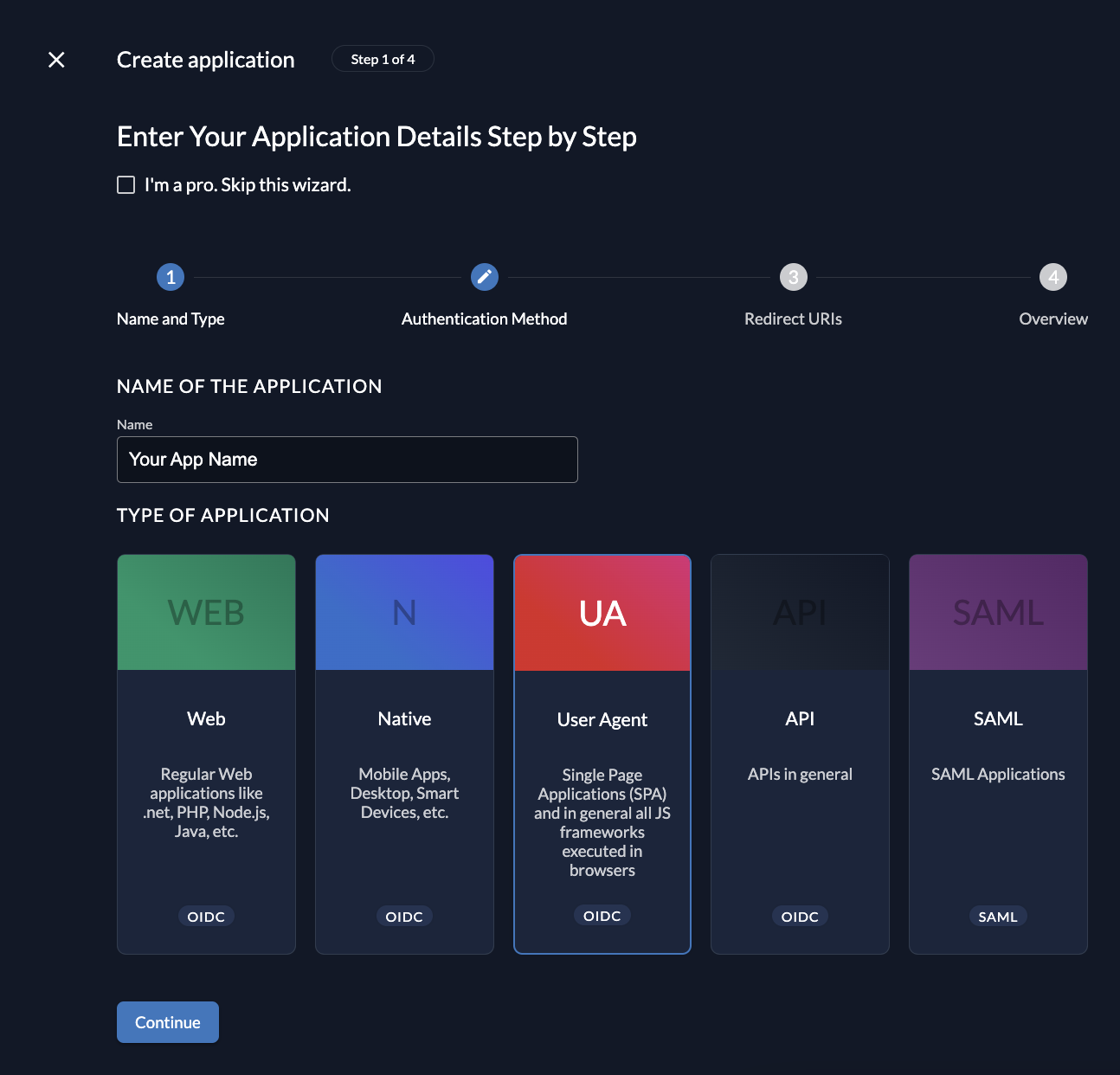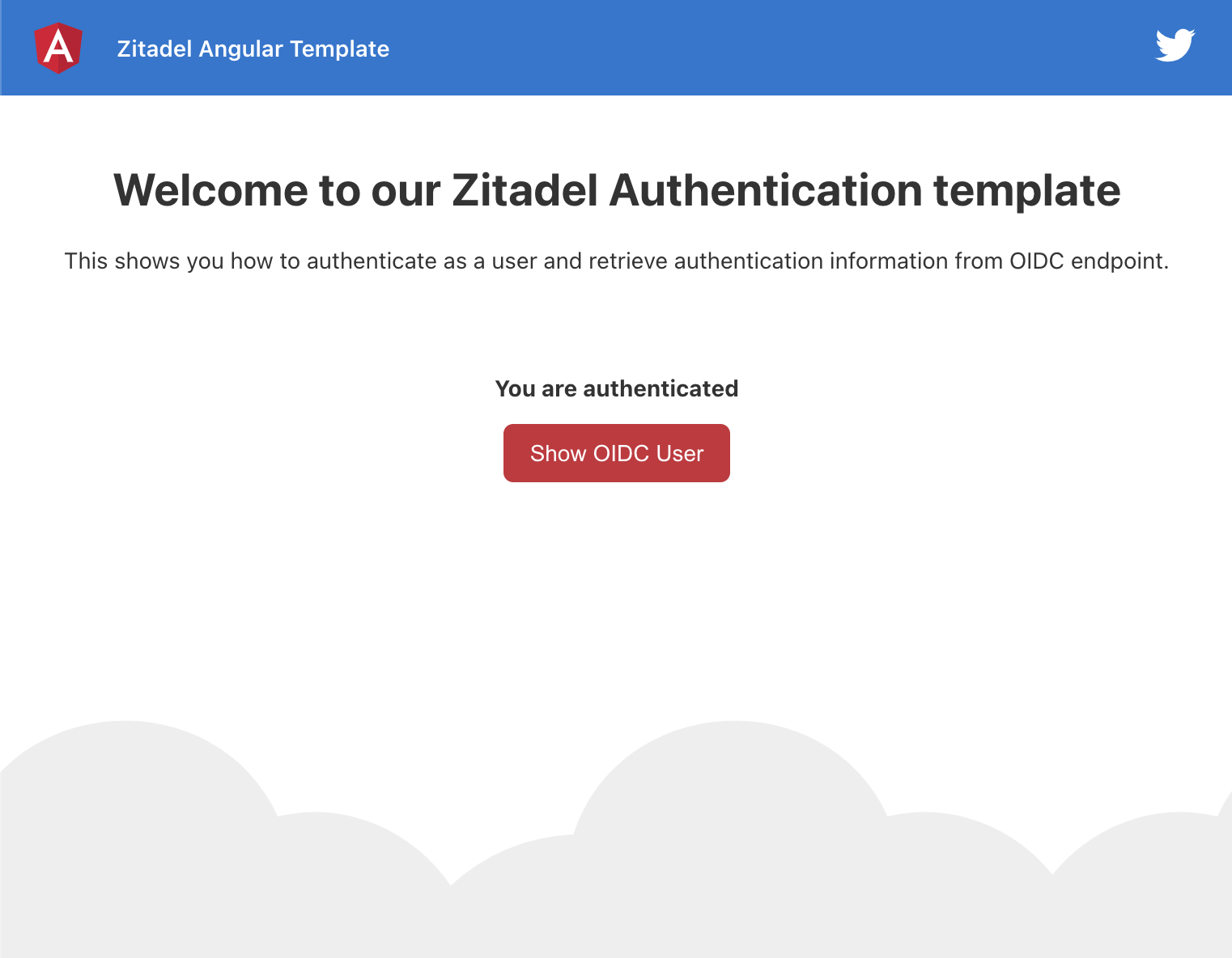ZITADEL with Angular
This integration guide demonstrates the recommended way to incorporate ZITADEL into your Angular application. It explains how to enable user login in your application and how to fetch data from the user info endpoint.
By the end of this guide, your application will have login functionality and will be able to access the current user's profile.
This documentation references our example on GitHub. Please note that we wrote the ZITADEL Console in Angular, so you can also use that as a reference.
Set up application and obtain keys
Before we begin developing our application, we need to perform a few configuration steps in the ZITADEL Console. You'll need to provide some information about your app. We recommend creating a new app to start from scratch. Navigate to your Project, then add a new application at the top of the page. Select the User Agent application type and continue. We recommend that you use Proof Key for Code Exchange (PKCE) for all SPA applications.

Redirect URIs
The Redirect URIs field tells ZITADEL where it's allowed to redirect users after authentication. For development, you can set dev mode to true to enable insecure HTTP and redirect to a localhost URI.
The Post-logout redirect send the users back to a route on your application after they have logged out.
If you are following along with the example, set the dev mode to
true, the Redirect URIs tohttp://localhost:4200/auth/callbackand Post redirect URI tohttp://localhost:4200/signedout.
Continue and create the application.
Client ID
After successful creation of the app, a pop-up will appear displaying the app's client ID. Copy the client ID, as you will need it to configure your Angular client.
Angular setup
Now that you have configured your web application on the ZITADEL side, you can proceed with the integration of your Angular client.
Install Angular dependencies
To connect with ZITADEL, you need to install an OAuth/OIDC client. Run the following command:
npm install angular-oauth2-oidc
Create and configure the auth module
Add OAuthModule to your Angular imports in AppModule and provide the AuthConfig in the providers' section. Also, ensure that you import the HTTPClientModule.
https://github.com/zitadel/zitadel-angular/blob/main/src/app/app.module.ts
Set openid, profile and email as scope, code as responseType, and oidc to true. Then create an authentication service to provide the functions to authenticate your user.
You can use Angular’s schematics to do so:
ng g service services/authentication
Copy the following code to your service. This code provides a function authenticate(), which redirects the user to ZITADEL. After a successful login, ZITADEL redirects the user back to the redirect URI configured in AuthModule and ZITADEL Console. Ensure that both correspond, otherwise ZITADEL will throw an error.
https://github.com/zitadel/zitadel-angular/blob/main/src/app/services/authentication.service.ts
Our example includes a StatehandlerService that redirects the user back to the route from which they initially came.If you don't need such behavior, you can omit the following line from the authenticate() method above.
https://github.com/zitadel/zitadel-angular/blob/main/src/app/services/authentication.service.ts#L45
If you decide to use the StatehandlerService, include it in the app.module. Ensure it gets initialized first using Angular’s APP_INITIALIZER. You can find the service implementation in the example.
https://github.com/zitadel/zitadel-angular/blob/main/src/app/app.module.ts#L26-L30
https://github.com/zitadel/zitadel-angular/blob/main/src/app/app.module.ts#L55-L78
Add login to your application
To log in a user, you need a component or a guard.
- A component could provide a button that initiates the login flow when clicked.
- A guard initiates a login flow when a user without a stored valid access token attempts to access a protected route.
The use of these components depends heavily on your application. In most cases, you need both.
Generate a component like this:
ng g component components/login
Inject the AuthenticationService and call authenticate() on some click event.
Do the same for the guard:
ng g guard guards/auth
This code shows the AuthGuard used in ZITADEL Console.
https://github.com/zitadel/zitadel-angular/blob/main/src/app/guards/auth.guard.ts
Add the guard to your RouterModule similar to this:
https://github.com/zitadel/zitadel-angular/blob/main/src/app/app-routing.module.ts#L9-L31
Note: Make sure you redirect the user from your callback URL to a guarded page, so the
authenticate()method is called again, and the access token is stored.
https://github.com/zitadel/zitadel-angular/blob/main/src/app/app-routing.module.ts#L19-L21
Add logout to your application
Call auth.signout() to log out the current user. Keep in mind that you can also configure a logout redirect URI if you want your users to be redirected after logout.
https://github.com/zitadel/zitadel-angular/blob/main/src/app/components/user/user.component.ts#L20-L22
Display user information
To fetch user data, you need to call the ZITADEL's user info endpoint. This data contains sensitive information and artifacts related to the current user's identity and the scopes you defined in your AuthConfig. Our AuthenticationService already includes a method called getOIDCUser(). You can call it wherever you need this information.
https://github.com/zitadel/zitadel-angular/blob/main/src/app/components/user/user.component.ts
And in your HTML file:
https://github.com/zitadel/zitadel-angular/blob/main/src/app/components/user/user.component.html
Refresh token
If you want to add a refresh token to your application, navigate to the console application and check the box in the configuration section.
Then add offline_access to the scopes and add the following line:
this.oauthService.setupAutomaticSilentRefresh();
This line automatically refreshes a token before it expires.
Completion
Congratulations! You have successfully integrated your Angular application with ZITADEL!
If you get stuck, consider checking out our example application. This application includes all the functionalities mentioned in this quick-start. You can start by cloning the repository and replacing the AuthConfig in the AppModule with your own configuration. If you face issues, contact us or raise an issue on GitHub.

What's next?
Now that you have enabled authentication, it's time for you to add authorization to your application using ZITADEL APIs. To do this, you can refer to the docs or check out the ZITADEL Console code on GitHub which uses gRPC to access data.
For more information on how to create an Angular application, you can refer to Angular. If you want to learn more about the OAuth/OIDC library used above, consider reading the docs at angular-oauth2-oidc.